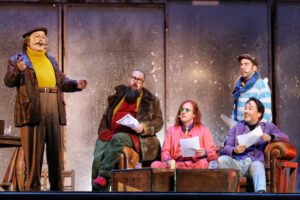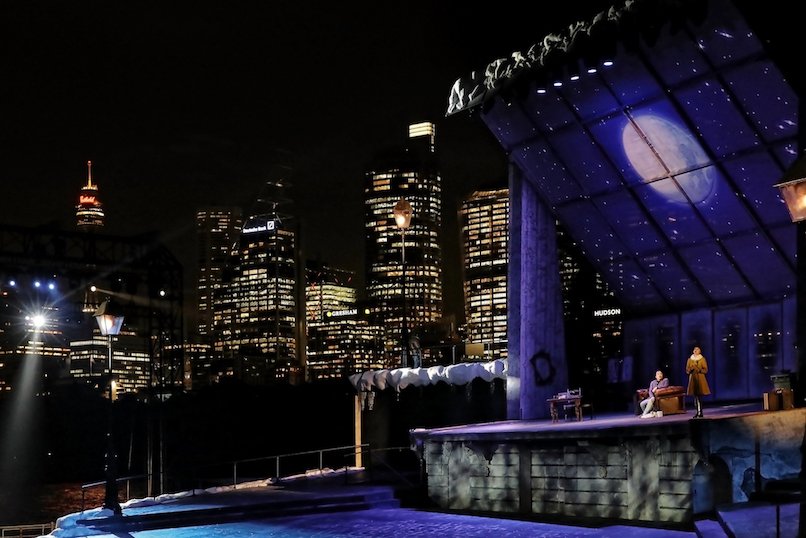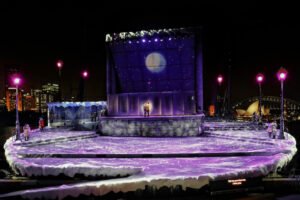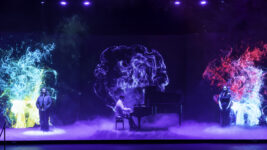News
25 Apr 2018
Track The Light Fantastic: Radio Tracking on La Boheme

Subscribe to CX E-News
FEATURE
Track The Light Fantastic: Radio Tracking on La Boheme
By Jason Allen.
Opera Australia’s Handa Opera on Sydney Harbour is always breathtaking, and it takes an army of technicians to handle the complex lighting, sound, and effects infrastructure it needs. In a trial of a new system for OA, this year they employed a Zactrack radio tracking system to partially automate the lighting rig, with spectacular results…
Zactrack is a simple yet powerful system in which small radio transmitters called tags are carried by performers or attached to set elements that beam their coordinates in x-y-z format to a control system (see in-depth Zactrack feature for a full-run down)

Matthew Marshall
“OA had been looking at Zactrack, and they asked if I was interested in doing a trial on this show,” said lighting designer Matthew Marshall. “I’ve always wanted to do back follow-spots, but never had the budget, so that capability alone plus solving some tricky problems with moving elements made it worth pursuing. We’re using it in key moments, but in the end we’ve used it a lot more than I thought we would.”
Fixtures on La Boheme automated with Zactrack include Martin Mac III Profiles, Claypaky Alpha 1500s, Claypaky Sharpies, and Martin Mac Auras.
“Normally we have two follow-spots,” added Matthew, “but we’ve replaced them with Zactrack. There’s some effects in the show that are only possible with Zactrack. One of the briefs was to be spectacular, and I realised tracking could help us achieve that. We use it in subtle ways as well. For example, in Act Three there’s back follow-spot moments where the leads are followed from upstage. It’s a beautiful look you can’t normally do unless you have two people in harnesses all night standing-by.”
Custom Parameters
Working closely with Matthew was Peter Rubie, lighting programmer tasked with getting their GrandMA2, the fixtures and Zactrack to play nice with each other. “For each fixture that can be controlled via Zactrack, I’ve built a custom fixture profile,” Peter illustrated.

Peter Rubie
“We’ve expanded each profile to include parameters just for Zactrack, like tag number assignment. As soon as we change the tag number, all the lights assigned change to following that tag. We can offset the x-y -z coordinate values as well.”Zactrack centres the light on the performer, but sometimes we want to light from the waist up, or a do headshot, so we change the z offset by 80 centimetres or so. During the moment when there’s a performer flown with balloons above them, we offset the z value by a metre to hit the balloons above the performer’s tag. It also means we can use one Zactrack transmitter and light multiple targets.”
“We’ve also incorporated other assignments like mode channels that determine what happens if the fixture loses the transmitter,” continued Peter. “There’s a perimeter defined around the stage, and if a performer leaves the stage and we forget to fade a light out in a cue, Zactrack will fade it out for us.
“The GrandMA2 is doing a lot of work in taking information from the console, sending it to the Zactrack server, and then getting it back. We send out our data on a lot of different universes, Zactrack listens to that, takes control of all the parameters it needs, and sends the changed data back to us, while passing through everything it doesn’t need. The reason we don’t go straight out of the desk is so we can keep control of both Zactrack and all of our fixtures.”
Precision Effects
The effect on the show is quite subtle overall, giving the impression that they have a lot of very well-rehearsed domies. “So much of lighting design is about focussing attention down to fine details,” observed Peter. “It’s such a huge stage; if you have to wash the whole thing to cover faces, you lose so much of the atmosphere.
“Having more control and more options is really good – there’s a moment where we track a car, and we use framing shutters to shape the light into a box that’s the shape of the car, so it’s not just this big circle hitting the rest of the stage. With precise fixtures like the Sharpies we punch a whole lot of light onto one performer’s reflective dress, and she lights up like a mirror ball. Half way through that scene, she does a throwing gesture, and we change the tag assignment and so all the beams instantly all track to another performer.”

Nick Bojdok
It’s not just the lighting crew who are benefitting form Zactrack’s tracking data – scenic video projections are using it to stay focussed too. “We’ve got three 32K Barco laser projectors on different parts of the scenery being driven by main and backup disguise servers,” said Nick Bojdok, Technical Manager for video provider Big Picture.
“Some of the scenery is movable, and we’ve got Zactrack transmitters mounted on them. Zactrack is giving us PosiStageNet data to track them up and down stage, and the disguise changes its mapping. It’s simple, and it gets rid of any discrepancies in positioning.
Sound Spatialisation
Meanwhile, sound designer and FOH mixer Tony David Cray is eying the data output by Zactrack for future use by the sound system. “This year, we’re just monitoring. Next year we’re adding it to the mix,” he confirmed. “There’s an unreleased kit from DiGiCo that can take OSC data that Zactrack outputs. Panning is only one part of it; we’re looking at putting in a spatialisation engine. That science is maturing.

Tony Cray
“Barco’s IOSONO has wavefield synthesis, but comes with processing delay that is a sum of the width of the system, so when we used it on Carmen here at Handa Opera on Sydney Harbour, we had a large delay on the system due to the size of the auditorium. But d&b audiotechnik’s Soundscape and L-Acoustic’s L-ISA take a different approach, and their processing delay is down to milliseconds.”
Tony is excited by the technical change heralded by 3D audio.“Companies that will survive this change will be the ones that are open to it,” he predicted. “I can sit here and write a programme in Max MSP and say, well, for this show I don’t always want the actors to come from where they are tracking on stage.
“Sometimes it’s like a film mix, where for a big aria, you want them front and centre sound-wise, even though they might be on the far end of the stage. We’re anticipating writing software that sits between tracking systems and the desk, then feeds it to a spatialisation engine.”
- Ho-Yoon Chung and Iulia Maria Dan
- Julie Lea Goodwin and John Bolton Wood
- Simon Gilkes as Parpignol – the ‘balloon tracking’ moment.
- Samuel Dundas
- La Boheme
- La Boheme
This article first appeared in the print edition of CX Magazine April 2018, pp.16-18. CX Magazine is Australia and New Zealand’s only publication dedicated to entertainment technology news and issues. Read all editions for free or search our archive www.cxnetwork.com.au
Photos: Prudence Upton © CX Media
See also: Zactrack: How It Works from the same issue.
Subscribe
Published monthly since 1991, our famous AV industry magazine is free for download or pay for print. Subscribers also receive CX News, our free weekly email with the latest industry news and jobs.
















